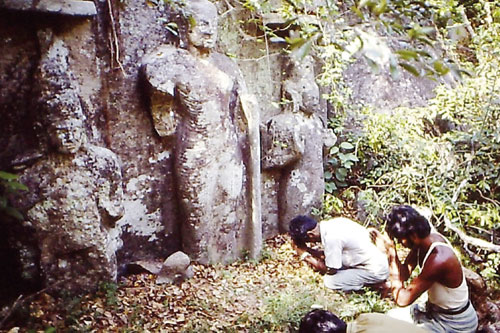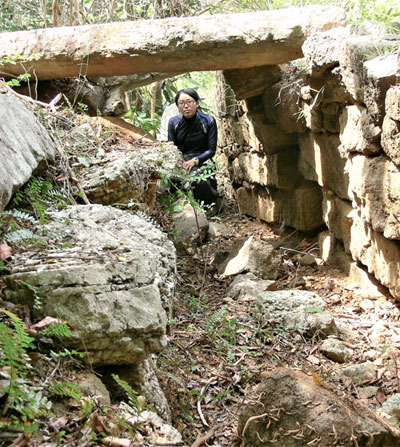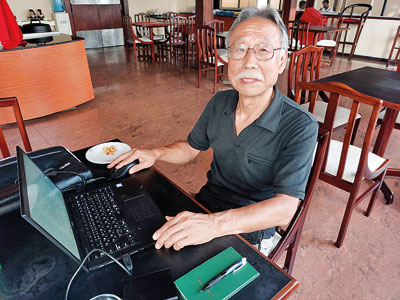Uncovering Lanka’s archaelogical secrets since the 1970s

Takashi Okamura at the site of the discovery of Buddha statues embedded in the rock face, north of Maligamuwa tank, Wasgamuwa National Park
Takashi Okamura has been on epic explorations in Sri Lanka from the 1970s. The Hosei University Exploration Club of which he is Chairman has made several ‘discoveries’ during their 11 explorations in Sri Lanka’s jungles and among its archaeological ruins from 1973 right up to 2018. Takashi has been the lead and member of seven of these forays.
Chairman also of the NPO-Sarers (South Asia Ruins and Exploration Society), Takashi now 74 years old, is the recipient of the prestigious Naomi Uemura Adventure Award, presented annually to accomplished Japanese adventurers in memory of Naomi Uemura, the first person to reach the North Pole, solo. Takashi has donated all the proceeds from this award to NPO-Sarers.
Here he talks of his experiences in Sri Lanka:
Well, I can be best described as ‘an old explorer’ (laughing). Since my early 20s, I, and a few of us at the Hosei University Exploration Club had a passion for adventure and exploration. The university is one of the largest in the Tokyo metropolitan area, and had many clubs and associations dedicated to both academic and extracurricular activities. The Exploration Club happened to be one of them.

Discovery of Budupatunna ruins in Wila Oya, 1985
Q: So what made you first come to Sri Lanka in 1973?
Well, interestingly, a few members of our club and I were transiting through Colombo in order to visit the Maldive Islands. The Maldives was a ‘new country’, having only recently achieved independence and we were keen on exploring it, including the many ruins that we had heard were on the island. When we landed in Colombo, the process of getting our visas for the Maldives was taking a very long time. A Tourism Board official suggested that as Sri Lanka has many more undiscovered ruins compared to the Maldives we should explore Sri Lanka instead! Thus the Mahaweli area exploration and expedition was born.
We started in Mahiyangana. Having transported all our equipment in a lorry, we managed to travel by road up to Hebarawa, which was a small village of about 100 families. We based ourselves there initially and explored the area on foot from the right bank of the Mahaweli for about two months. In total we recorded about 31 temple archaeological sites and about 10 irrigation sites. Most, save for a handful, were all new sites that had not been recorded by the Dept of Archaeology at the time. We then moved up to Yakkure and based ourselves in the jungles there for about another 1 ½ months.

Hosei University team exploring the Mahaweli river from Manampitiya to Trincomalee, at the end of their 1973 expedition to discover ruins in the east bank
In all my expeditions in Sri Lanka these areas had some of the thickest jungles then, and I remember we had two local hunters, Punchi Nande and Sunil who accompanied us, along with an interpreter named Ananda. Having conducted those surveys we then decided to continue by dinghies from Manampitiya all the way to the Mahaweli estuary at Koddiyar Bay. This took us over a week, partly as we spent a lot of time in and around what were then very thick mangrove forests at the estuary.
The discoveries made in ’73 fascinated us, and we knew there will be more. The second expedition, with five of our members, covered further east along the Maduru Oya basin into areas such as Pimburettewa, Omunugala and Toppigala. Here too we recorded over 30 sites.
Yes, but before that a group of our students had made a visit in 1976 and explored the left bank and southern edge of what was later the Wasgamuwa National Park where they recorded about 38 sites. When I returned in ’85 with a seven-member team, the Mahaweli Development programme had opened up a lot of the lands that we had explored on the right bank. These were all now new settlements and agricultural lands. The Dept of Archaeology themselves suggested we transfer our efforts to the southern jungles, which had been little explored. We based ourselves at Kotiyagala and started to explore the jungles south from there. Spent about two months here, again mapping about 51 sites that had hitherto not been recorded.
 Q: There was the epic discovery of the Budupatunna relief statues during that expedition. Tell us a bit about that
Q: There was the epic discovery of the Budupatunna relief statues during that expedition. Tell us a bit about thatThat was a funny discovery. We were traversing along the dry riverbed of Wila Oya when one of the team members said he needed to relieve himself. So we stopped while he went into the forest, and he accidentally discovered this site. We had three local guides, Seneviratne, Karunasundera and Yahapath hami, all who guided us to most of these sites, but even they were astounded at this find. These were some of the most beautiful Buddha and Bodhisatva relief statues I have seen.
Yes, Senerath Dissanayake was then the Director Exploration at the Dept of Archaeology. They had attempted to locate Budupattuna three times after that based on our details but had failed to find it, so he requested us to come back to conduct our first joint Hosei Uni-Dept of Archaeology expedition.
Sadly, the Budupattuna statues had been broken up and vandalised by treasure hunters by the time we got there.
That was initially the right bank of the Kumbukkan, into Yala SNR (Strict Nature Reserve) and a joint expedition with the Dept. of Archaeology but they spent about a week and didn’t find anything. The Hosei team continued exploring the left bank for about one month after that, inside Kumana, and it was then that they rediscovered Weheragala Kanda (originally mentioned in the books by Nihal Fernando and Ven. Ellawala Medhananda), and the reclining Buddha and Bodhisatva statues.

Takashi Okamura on a brief visit to Colombo last month and pictured on our magazine cover at the Sudu Kanda site Wasgamuwa National Park
Q: You returned to Wasgamuwa in 2010
Yes, but that wasn’t too successful. We found about five sites. We of course, mapped the Malgamuwa tank, its very large and unique twin Bisokotuwas and surrounding relief statues. The student team that came subsequently in 2011 mapped out the very large and impressive Sudukanda archeological site inside Wasgamuwa. A student team also came in 2013 and worked on the Kaludiya Pokuna site close to Sigiriya.
2016 was to attempt to go to Thalaguruhela, inside Yala Block III (also originally mentioned in the books by Nihal Fernando and Ven. Ellawala Medhananda). We had decided to approach it from the north, from where the Kumbukkan Oya is the closest to it. We had guides from Maligawila, and even GPS points, but the approach was so thickly forested, and with very thorny underbrush that we failed to reach the site over a two-week period. The Department of Wildlife had also prohibited us from setting up any camps in the park, so we had to return to base camp on each day we tried, ideally before dark. The next time in 2018 we decided to approach from Galge and set up base camp inside the park. We spent about two days at the site and mapped out many others such as Pilimagala and Malwariyakema as well.
First, I must tell you it was very sad for me to see so many sites and statues vandalised and destroyed, compared to how we had first seen them. During our various expeditions we have attempted to create programmes and awareness, especially among young schoolchildren, on the value of archaeological heritage and the need to protect it. We hope to conduct a joint expedition with the Dept. of Archaeology in the Somawathiya area. This is an area, I believe, that has a deep history and is still relatively under-explored.
Detailed reports of the Hosei University expeditions in Sri Lanka can be downloaded from:http://npo-sarers.org/
Searching for an ideal partner? Find your soul mate on Hitad.lk, Sri Lanka's favourite marriage proposals page. With Hitad.lk matrimonial advertisements you have access to thousands of ads from potential suitors who are looking for someone just like you.


